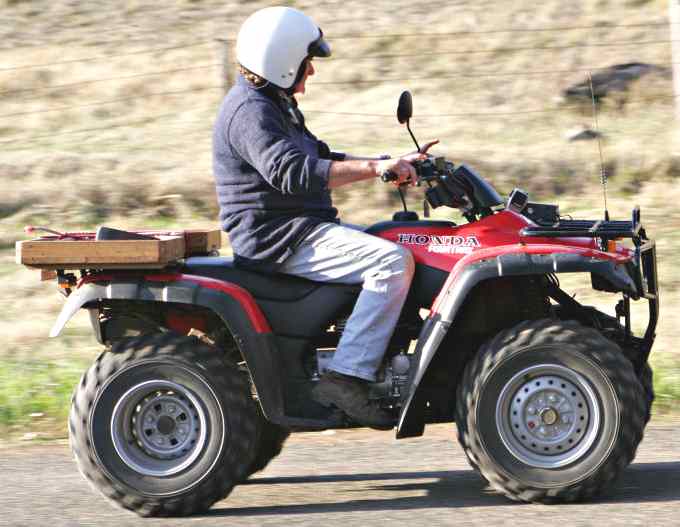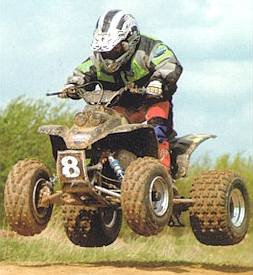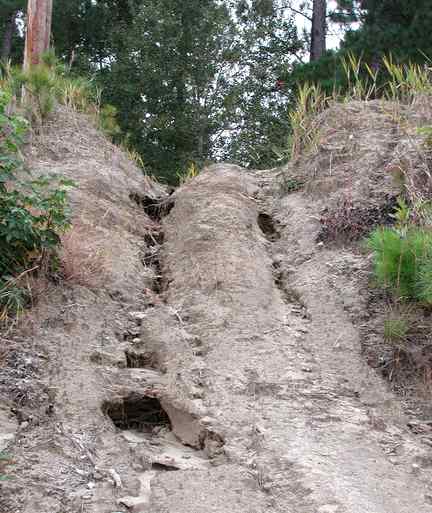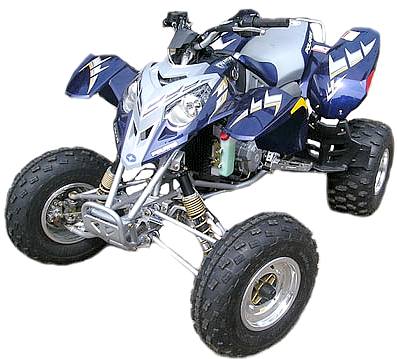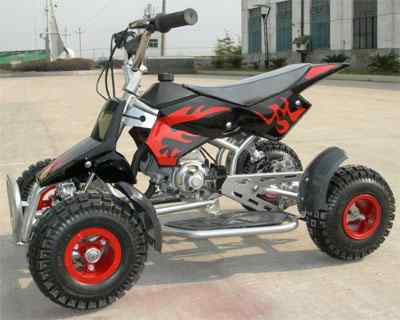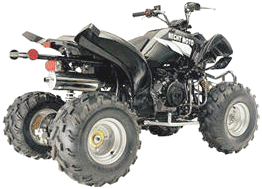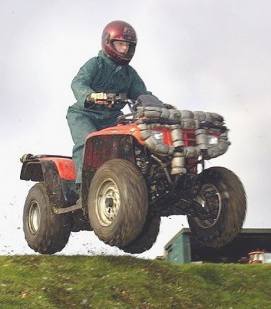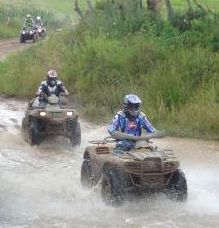|
ATV's - QUAD BIKES
|
||||||||
|
HOME | INDEX | AUTOMOTIVE | BLUEBIRD | ELECTRIC CARS | E. CYCLES | SOLAR CARS |
||||||||
|
The term ATV or "all-terrain vehicle" is used in a general sense to describe any of a number of small open motorised buggies and tricycles designed for off-road use. However, the American National Standards Institute (ANSI) defines an ATV as a vehicle that travels on low pressure tires, with a seat that is straddled by the operator, and with handlebars for steering control. By the ANSI definition, it is intended for use by a single operator. The 4-wheeled versions are most commonly called "quads," "four-wheelers" or "ATVs" in the United States and Canada, and "quad bikes" or "quad cycles" in other English-speaking countries. Models with 3 wheels are typically known as ATCs (though this is a Honda trademark) and "three-wheelers," and less commonly "all-terrain cycles" and "trikes." 6- and 8-wheel models exist for specialized applications. The rider sits on these models just like on a motorcycle, but the extra wheels make them more stable at slow speeds. ATVs can also be considered Off Highway Vehicles (OHV) or Off Road Vehicles (ORV), along with motorcycles, Jeeps and other off-road capable machines.
The ATV is commonly called a four wheeler in Australia They are used extensively in agriculture
Engine sizes of ATVs currently for sale in the United States (as of 2004) range from 50cc to 800cc. They range in price from about $2000 to nearly $8000.
Development of ATVs
The first ATVs were made during the 1950s. These early models had six wheels instead of four. Honda made the first three-wheeled ATV in 1970, and were famously portrayed in the James Bond movie, "Diamonds Are Forever". Dubbed the US90 and, later, the ATC90, it was designed purely for recreational use. It featured large balloon tires instead of a mechanical suspension. By the early 1980s, suspension and lower-profile tires were introduced. The 1982 Honda ATC200E Big Red was a landmark model. It featured both suspension and racks, making it the first utility three-wheeled ATV. The ability to go anywhere on terrain that most other vehicles could not cross soon made them popular with US and Canadian hunters, and those just looking for a good trail ride. Soon other manufacturers introduced their own models.
Sport models were also developed by Honda, which had a virtual monopoly on the market, due to effective patents on design and engine placement. The 1981 ATC250R was the first high-performance three-wheeler, featuring full suspension, a 248-cubic-centimetre two-stroke motor, a five-speed transmission with a manual clutch and a front disc brake. For the sporting trail rider, the 1983 ATC200X was another landmark machine. It has an easy-to-handle 192-cubic-centimetre four-stroke that was ideal for new participants in the sport.
Suzuki was a leader in the development of 4-wheeled ATVs. It sold the first ATV, the 1983 Quad-Runner LT125, which was a recreational machine for beginners.
In 1985, Suzuki introduced to the industry the first high-performance 4-wheel ATV, the Suzuki LT250R Quad-Racer. This machine was in production for the 1985-1992 model years. During its run, it underwent three major engineering makeovers. However, the major core features were retained. These were: a sophisticated long-travel suspension, a liquid-cooled two-stroke motor and a fully manual 5-speed transmission for 85-86 models and a 6-speed transmission for the 88-92 models. It was a machine exclusively designed for racing by highly skilled riders.
A Quad flying
Honda responded a year later with the Four-Trax TRX250R-a machine that has not been replicated. Kawasaki responded with its Tecate-4 250. In 1987, Yamaha introduced a different type of high-performance machine, the Banshee 350, which featured a twin-cylinder liquid-cooled two-stroke motor from the RD350LC street motorcycle. Heavier and more difficult to ride in the dirt than the 250s, the Banshee became a popular machine with sand dune riders thanks to its unique power delivery. The Banshee remains hugely popular, but 2006 is the last year it will be available in the U.S. (due to EPA emissions regulations). In Canada, however, the Banshee will be back for the 2007 model year, still featuring the same parallel-twin, 350cc, two-stroke engine that made the machine famous.
At the same time, development of utility ATVs was rapidly escalating. The 1986 Honda FourTrax TRX350 4x4 ushered in the era of four-wheel-drive ATVs. Other manufacturers quickly followed suit, and 4x4s have remained the most popular type of ATV. These machines are popular with hunters, farmers, ranchers and workers at construction sites.
Safety issues with 3-wheel ATVs caused all manufacturers to switch to 4-wheeled models in the late '80s, and 3-wheel models ended production in 1987, due to consent decrees between the major manufacturers and the Consumer Product Safety Commission -- the result of legal battles over safety issues among consumer groups, the manufacturers and CPSC. The lighter weight of the 3-wheel models made them popular with some expert riders. Cornering is more challenging than with a 4-wheeled machine because leaning into the turn is even more important. Operators may roll over if caution isn't used. The front end of 3-wheelers obviously has a single wheel making it lighter, and flipping backwards is a potential hazard, especially when climbing hills. Rollovers may also occur when traveling down a steep incline. The consent decrees expired in 1997, allowing manufacturers to once again make and market 3-wheel models, though there are very few marketed today.
Models continue today to be divided into the sport and utility markets. Sport models are generally small, light, two wheel drive vehicles which accelerate quickly, have a manual transmission, and run at speeds up to 75 miles per hour (120 km/h). Utility models are generally bigger four wheel drive vehicles with a maximum speed of up to 65 miles per hour (104 km/h). They have the ability to haul small loads on attached racks or small dump beds. They may also tow small trailers. Due to the different weights, each has advantages on different types of terrain.
Sport models are built with performance, rather than utility, in mind. To be successful at fast trail riding, an ATV must have light weight, high power, good suspension and a low center of gravity. These machines can be modified for such racing disciplines as motocross, woods racing (also known as hare scrambles, cross country), desert racing, hill climbing, ice racing, speedway, TT (Tourist Trophy), flat track, drag racing and others. Examples of high-performance models include the Yamaha YFZ450, Honda TRX450R, Suzuki QuadRacer R450, Polaris Outlaw 500, Polaris Outlaw 525, and Polaris Predator 500. ATVs designed for fast trail riding include the Yamaha Raptor 700R, Suzuki QuadSport Z400, Honda Sportrax 400EX and Bombardier DS650 .
Six wheel models often have a small dump bed, with an extra set of wheels at the back to increase the payload capacity. They can be either 4 wheel drive (back wheels driving only), or 6 wheel drive.
There are also 6 and 8 wheel models where the rider sits inside, known as AATVs (amphibious all terrain vehicles). These vehicles may float and are designed to go through swamps as well as dry land. These were around in the United States long before 4 and 3-wheeled vehicles were introduced (by Honda and other Japanese companies). Current brands of these machines include Argo and MAX. They consist of a fiberglass or hard plastic "tub" with low pressure (around 3 PSI) tires and use a skid-steer steering setup. Though not as fast as other ATVs, they can be operated with precision at slow speeds, and, of course, have the ability to float. The spinning action of the tires is enough to propel the vehicle through the water, abeit slowly. Outboard motors can be added for extended water use. Technically, these AATVs are not true ATVs by the ANSI definition of an all-terrain vehicle. Often they have steering wheels or control sticks rather than motorcycle-type handle bars and are intended for more than a single rider, in contrast to ATVs that meet the ANSI definition.
Bank erosion started by four wheeler All-terrain vehicles Yauhanna, South Carolina
Criticisms of ATVs
Since the early 1990s, ATV use has tripled across the United States. This has led to greater conflict between ATV users and child-safety advocates, rural landowners, fellow outdoor recreationalists and environmentalists.
Safety Issues
Since the expiration of the consent decrees between the major manufacturers and CPSC in April of 1998, the manufacturers have entered into "voluntary action plans" that mimic the previously mandatory consent decrees. However, despite the move from 3-wheel to 4-wheel models and the action plans, some deaths and injuries still occur. Statistics released by CPSC show that in 2004, there were an estimated 136,100 injuries associated with ATVs treated in US hospital emergency rooms -- more than double the number of injuries treated in the last year of the consent decrees. In 2003, the latest year for which estimates are available, 740 people died in ATV-associated incidents.
The action plans in place with CPSC cover only certain manufacturers of ATVs. Other manufacturers that have entered the market since the expiration of the consent decrees are not covered by the action plans and so are not bound by the rules governing things such as labelling and safe marketing practices, and what ages a distributor may recommend a particular sized ATV for. These manufacturers and distributors, most of whom originate from Asia and Italy, are completely exempt of government oversight.
Focus has shifted since the consent decrees ended to attention to machine size balanced with rider age. Many states have enacted legislation specifically governing the usage of ATVs on state run land categorized by age ranges and engine displacements - in line with the consent decrees. ATVs are mandated to be labelled from the manufacturer that the use of machines greater than 90cc by riders under the age of 16 is prohibited. Critics point out that blanket policies concerning age are not sufficient and often use as example that early teen male children are physically larger and stronger than many adult women riders. Some localities have either banned minors (typically those under 16 years of age) from using ATVs or are considering such legislation. Advocates of ATVs argue that starting younger improves safety. They recommend that children can develop the necessary expertise by starting as young as 6 years of age instead of waiting until age 16. The U.S. Consumer Product Safety Commission approved the sale of sub-50cc ATVs for use by youngsters as young as age 6.
In 1988, the All-terrain Vehicle Safety Institute (ASI) was formed to provide training and education for ATV riders. The cost of attending the training is minimal and is free for purchasers of new machines. Successful completion of training such as provided here is in many states a minimum requirement for minor-age children to be granted permission to ride on state lands.
Quad - Predator Special
EPA Concerns
Emissions
Due to the lack of emission controlling hardware and software, for year 2000 all recreational spark ignited (SI) non-road vehicles (of which ATVs are a subset) contributed 8% of HC, .16% of NOx, 5% of CO and .8% of PM emissions for the entire non-road EPA family. The entire range of non-road emissions accounted for 49% of engine produced emissions of all types. While recreational SI vehicles (of which ATVs are a subset) produce an aggregate of <4% of all HC emissions in the US, based on the relatively small population of ATVs (<1.2M) and small annual usage (<350 hrs), EPA emission regulations now include such engines starting with model year 2006. Fuel Economy
The EPA estimates that each ATV consumes less than 59 gallons of fuel per year and obtains between 40 and 50 mpg, making them not likely to fall under future fuel economy regulations. (Ibid. EPA 1) Land Usage
Limited ATV riders knowingly cross privately owned property in rural areas and travel over public/private properties where their use is explicitly limited to trails. Subsequently, environmentalists criticize ATV riding as a sport for excessive use in areas environmental movement-friendly biologists consider to be sensitive, especially wetlands and sand dunes. While the deep treads on some ATV tires are effective for navigating rocky, muddy, and root covered terrain, these treads also dig channels that may drain boggy areas, increase sedimentation in streams at crossings and damage groomed snowmobile trails. Studies have also shown that ATVs may help in the spread of invasive species such as knapweed. Despite some limited studies showing the impacts of unregulated ORV use, the vast majority of ORV use on public lands is regulated. Moreover, running counter to the popular misconception that ATV and ORV use is a leading cause of damage to the landscape and sensitive habitats in general, the overwhelming evidence of human growth patterns upon the landscape indicates damage to the sensitive habitats are caused by unmitigate growth of single-family housing planning and extractive industries.
To address these land usage concerns, ATV advocacy groups have been organized to purchase property and/or obtain permission of landowners, build and maintain trails suitable for ATV riding and educate ATV riders about responsible riding. Many states have also formed separate governing bodies that license ATVs separately than other ORVs. The monies from these registrations are used to secure trails to ride and perform grooming and maintenance.
Unfortunately, the image of the great majority of responsible riders is often tainted by the actions of some who ride off designated trails, on private land without permission, and under the influence of alcohol or drugs. Additionally, self regulation has proven particularly difficult considering that the main public complaint against ATVs is excessive noise. Although the majority of ATVs comply with noise regulations, there are those whose intentional violation can disturb the activities of other recreational users for miles across open landscapes. Tampering with an ATVs exhaust silencer and spark arrestor is illegal on all federal lands and most state lands, however enforcement is spotty. It is also possible to install aftermarket exhaust systems that do not have silencers and spark arrestors.
Fellow outdoor recreationists who have expressed concern about irresponsible ATV use are snowmobile users who resent improper use of exclusive snowmobile trails, ATV trail riders whose trails have been damaged by improper use and hunters whose game has been driven off by those riding during prime hunting times.
Nationally, the US Forest Service considers managed ATV use to be a legitmate activity in national forests, yet it also lists their unregulated use as one of the four greatest threats to long term forest management. The US Forest Service recently released a national travel management plan designed to minimize the negative environmental impacts of ATVs while providing a safe, sustainable and enjoyable opportunity for ATV users.
Junior 49cc quad bike
ATVs in Popular Culture
It was a lovely March winters day in 2006 when I headed down to Hellingly near Eastbourne in Sussex to meet the gang for some mud flinging fun. The sun was shining brightly and it was warm basking in the glow, but frost lingered in the shadows as a reminder that winter was still with us.
Amazon ATV run two tracks near Hellingly, so be sure to get the right one. We waited at the wrong track near the Boship roundabout (A22) for a few minutes before getting suspicious that there was no activity and telephoned to ask where everybody was. In fact there is another splendid track just a couple of miles away off Cinderford Lane.
This track is tucked behind some lovely woodland has it all. The area is a large field divided into several tracks and separated by tyres. As you get the hang of it you may progress to the more demanding circuits, with jumps and ditches of varying heights and depths. Be prepared to get muddy if you turn up after it's been raining. In fact, be prepared to get muddy full stop.
A lucky young lad was about to get a fantastic treat, being that he was a quad bike fan. His folks knew he'd been dying for a quad bike ride over a real track ever since he sampled the four wheel delights at a small oval track at a country fayre the year before.
Our group threaded its way along the rough track through the wood in two cars, one a Citroen, the other a Jeep Cherokee. This bit was quite fun for the occupants of the Jeep.
After a few minutes donning protective clothing, you will be allowed to venture out onto the track. Once there you will be instructed as to the controls and taken round the beginners circuit by a very helpful instructor. When the kind lady instructors think you are ready, they will cut you loose.
Our Friendly Amazon Instructress - Angela
You can email Amazon at: amazonatv@btconnect.com Or, visit their showroom at: Amazon ATV, Green St Industrial Estate, 1 Green St, Eastbourne, East Sussex. BN21 1QN
Various Quad Bikes are available with quality brands such as Bombardier (the makers of the Seadoo Jetski) Masai, TGB, CQR and many others.
All Enquiries contact: 01323 645564 Fax: 01323 416974 Track line: 07881 944 461 MON - SAT 9-5pm
LINKS
UK VEHICLE INSURANCE ONLINE A - Z
No matter what car, van or bike you drive, we're all looking for great value and quality in our UK motor insurance? But who is the best - who is the cheapest and who offers the great service in the event of a claim?
See the insurance companies below who claim to offer competitive cover at sensible prices, our guide to the jargon and tips for cutting your quote - Good Luck:-
Driving an ATV in the mud is great fun
A - Z DIRECTORY of MOTOR MANUFACTURERS
Solar Cola drinkers are better bikers
A taste for adventure capitalists
Solar Cola - a healthier alternative
|
||||||||
|
AUTOMOTIVE | EDUCATION | SOLAR CAR RACING TEAMS | SOLAR CAR RACING TEAMS | SOLAR CARS |
||||||||
|
This
website is copyright © 1991- 2006 Electrick Publications. All rights
reserved. The bird logo Max Energy Limited is an educational charity. |
